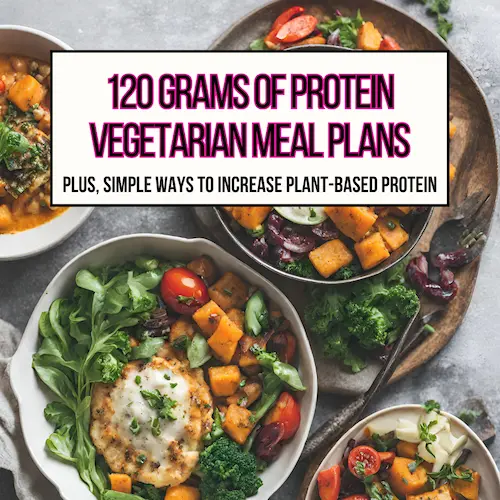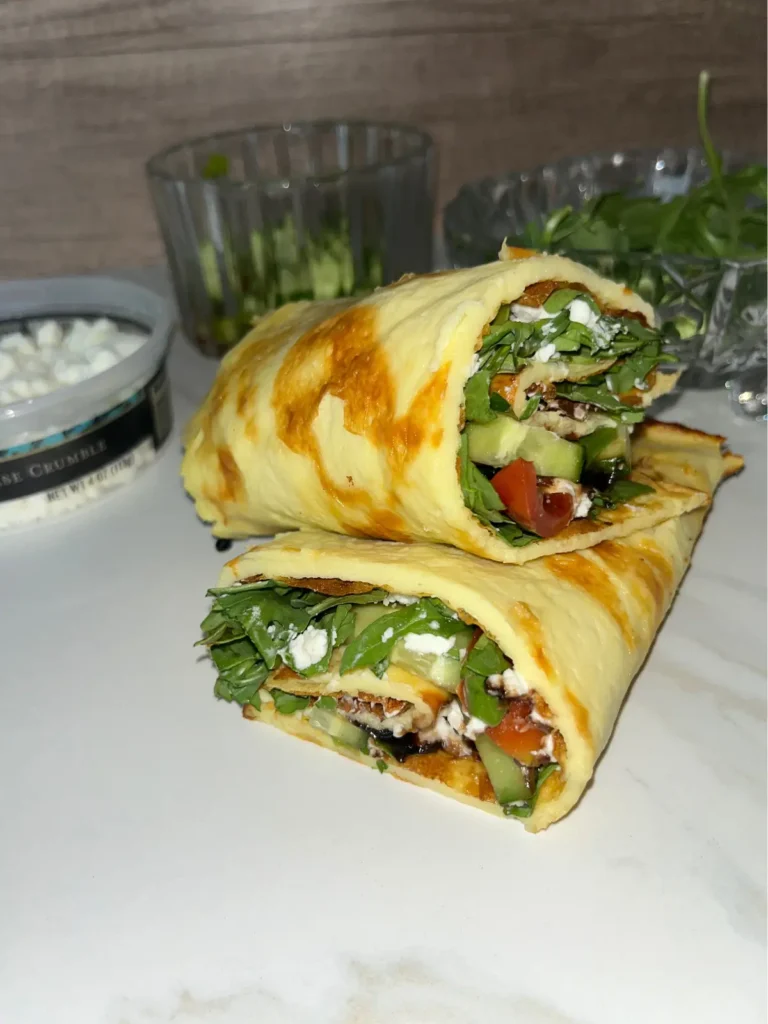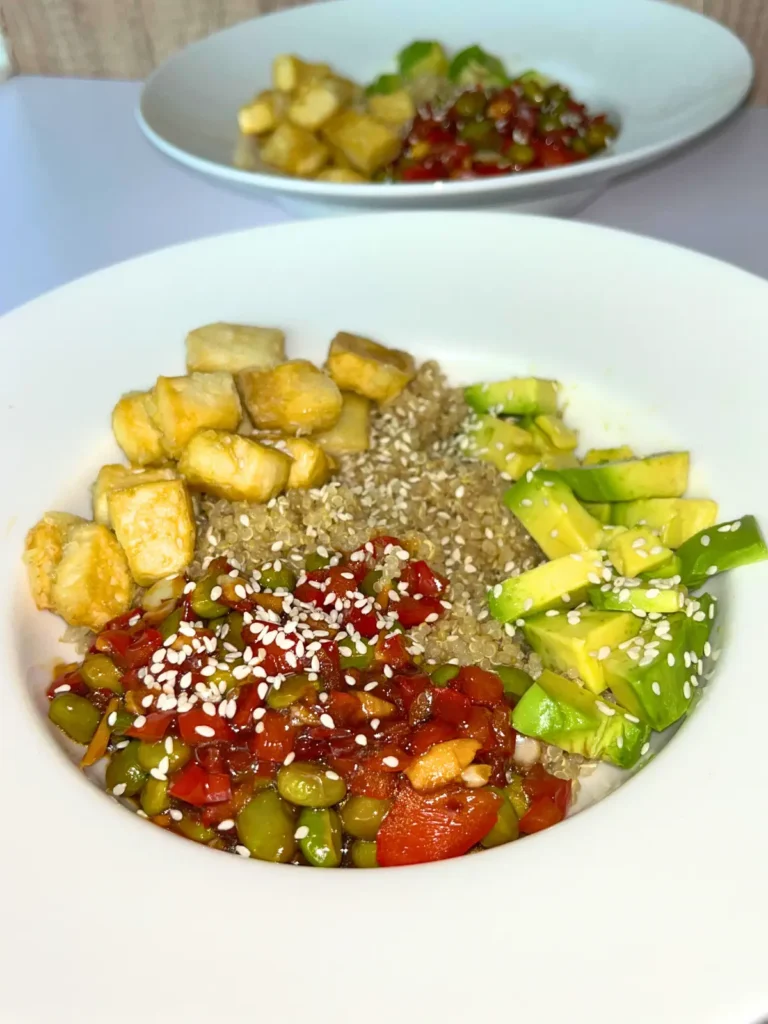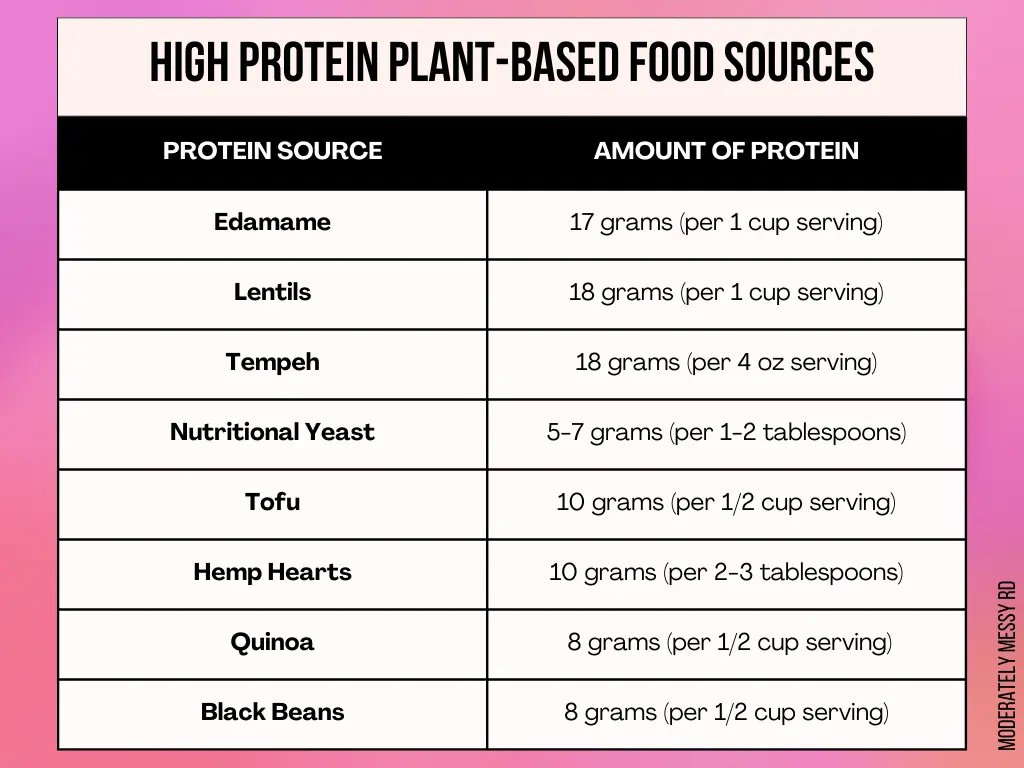The popularity of plant-based diets is on the rise! Since my protein meal plans seem to be some of my most popular posts, I decided to switch the focus to 120 grams of protein vegetarian meal plans for individuals who want to prioritize more plant-based meals.

This post will discuss the health benefits of consuming more plant-based meals and how to get 120 grams of protein as a vegetarian with high-protein vegetarian recipes and ideas to increase protein intake.
Whether you’re a vegetarian or just trying to eat a more plant-based diet, making protein a priority can help with changes in body composition, blood sugar levels, and promote feelings of fullness and satisfaction.
Health Benefits of a More Plant-Based Diet
Plant-based diets are often recommended by physicians to promote optimal health. The Academy of Nutrition and Dietetics states that an appropriately planned vegetarian diet may reduce the risk of chronic diseases such as ischemic heart disease, type 2 diabetes, hypertension, certain types of cancers, and obesity.
Research has also shown that those following a more plant-based diets typically have a lower BMI. Going plant-based is often more environmentally-friendly and cost-effective as well.
How Much Protein Do You Need Per Day?
How much protein does one need per day? A somewhat controversial question. The current recommended daily allowance (RDA) for protein is 0.8 g/kg/day, which is the minimum amount we should consume daily to prevent loss of lean body mass. This equates to 55 grams of protein for a 150-pound adult.
However, this might not represent the most optimal intake – with organizations such as the American College of Sports Medicine and the International Society of Sports Nutrition recommending 1.2-2.0 g/kg/day. Calculated for a 150-pound person, that’s 100-136 grams of protein per day.
Plant-based protein sources contain essential amino acids in lower quantities as compared to animal sources, therefore, it is often said that consuming a higher protein diet as a vegetarian is ideal.
How to Get 120 Grams of Protein Per Day As a Vegetarian
https://www.mayoclinichealthsystem.org/hometown-health/speaking-of-health/are-you-getting-too-much-protein
Studies have found that 20-30 grams is the “ideal” amount of protein to eat at each meal to promote muscle protein synthesis, and aid in digestion and absorption. Even further, most of the research shows that eating more than 40 grams of protein per meal does not have additional benefits, and could just be a waste of money. Therefore, it’s best to distribute your protein evenly throughout the day – which has been shown to help with an overall higher protein intake.
The best way to do this is to consume meals with about 20-30 grams of protein, with two snacks consisting of 15 grams of protein each.
Related Posts:
— High Protein Plant-Based Meal Prep Guide
— Plant-Based Meals with At Least 20 Grams of Protein
— High Protein Vegetarian Snack Ideas
Vegetarian Meal Plans with 120 Grams of Protein
By selecting one of each of these recipes for breakfast, lunch and dinner plus two snacks will amount to around 120 grams of protein per day. Some of these recipes prioritize animal products, like cottage cheese and Greek yogurt – while others are plant-based.
The truth of the matter is it can be hard to find plant-based recipes with at least 20 grams of protein per serving. Use this as a guide to piece together your own 120 grams of protein vegetarian meal plan based on your preferences and lifestyle! Protein breakdown included for each recipe.
For more recipes, read 35+ Plant-Based Meals with At Least 20 Grams of Protein.
Breakfast

— High Protein Vegan Avocado Toast from Vancouver with Love (497 kcal, 16g protein) + 8 ounce glass of plant-based milk.
— Creamy Strawberry Gut Health Smoothie; (316 kcal, 22g protein)
— Scrambled Eggs with Cottage Cheese from Feel Good Foodie + 1 slice of whole wheat toast (300 kcal, 22g protein).
— Banana Cinnamon Overnight Oats (385 kcal, 30g protein).
— 3 Kodiak Cake pancakes + 1/2 cup Greek yogurt mixed with 1 Tbsp. maple syrup toppings (300 kcal, 30g protein).
— Tofu Scramble from Rainbow Plant Life topped with 2 Tbsp. hemp hearts (350 kcal, 23g protein)
— Chia Breakfast Bowl (400 calories, 22g protein).
— Berry Cheesecake Overnight Oats (376 calories, 37g protein).
Lunch
When building a higher protein meal, think about those little additions that can really add up – like cheese, nuts, and hemp hearts. Check out The Best Grocery List Staples to Increase Protein Without Meat for more ideas.

Lunch ideas with 20-30 grams of protein.
— Seitan Gyro Wraps from Yum Vegan Food (459 calories, 28g protein).
— Cottage Cheese Flatbread, shown above (350 calories, 40g protein).
— Vegan Lentil Burgers from Food Network (560 calories, 21g protein).
— Tempeh Butternut Squash Bake from Eating Bird Food (363 kcal, 37g protein).
— Tempeh, Lettuce and Tomato Sandwich from Whitney E. RD (estimated ~400 kcal, 21g protein).
— Vegan White Bean Salad from The Spruce Eats (586 kcal, 38g protein).
— White Bean Soup with Quinoa from Cooking for Peanuts (519 kcal, 22g protein).
— Lentil Salad from Skinnytaste (two servings – 360kcal, 20g protein).
— Tofu & Edamame Bowl (335 calories, 22g protein).
Snacks

Ideally, select two snacks to help you reach 120 grams of protein per day.
— High Protein Mini Strawberry Cheesecake Cups (88 kcal, 15g protein).
— Greek yogurt topped with 1 Tbsp. chopped nuts (150 kcal, 16g protein).
— Egg Salad (~170 kcal, 12g protein).
— Matcha Smoothie Bowl from Running on Real Food (261 kcal, 24g protein).
— Whipped Cottage Cheese on Toast (155 kcal, 18g protein).
— RX Bars (230 kcal, 12g protein).
— Aloha Organic Plant-Based Protein Bars (240 kcal, 14g protein).
— Roasted Chickpeas (about 15g for 1 cup).
— Edamame (about 10 grams per 1/2 cup).

This post does contain Amazon affiliate links. At no additional cost to you, I receive a small compensation if a purchase is made. I only promote products I think are useful.
Dinner
— Almond Butter Tofu Stir-Fry from The Minimalist Baker (436 kcal, 22.8g protein).
— Seitan and Black Bean Stir-Fry from BBC Good Food (326 kcal, 22g protein).
— Spicy Quinoa and Black Beans from Bowl of Delicious (450 kcal, 24g protein).
— Cottage Cheese Mac and Cheese (500 kcal, 28g protein).
— Lemon Tempeh Air Fryer Sheet Pan Dinner from Fat Free Vegan Kitchen (463 kcal, 35g protein).
— Cashew Noodles with Broccoli and Tofu from Whole Foods Market (480 kcal, 24g protein).
— Jacked Up Vegan Ribs from Fat Free Vegan (398 kcal, 35g protein).
— Edamame Stir Fry from Food Folks and Fun (416 kcal, 20g protein).
Plant-Based Protein sources
Below is a table of some of the best plant-based protein sources and the amount of protein in each serving. I also can’t recommend cottage cheese and Greek yogurt enough as a vegetarian source of protein.

Simple Ways to Increase Protein As A Vegetarian
1. Add nuts and seeds to meals.
- Sprinkle hemp hearts (10 grams of protein per serving) on oatmeal, yogurt, or in soups and smoothies.
- Add chopped walnuts to power bowls or salads.
2. Nutritional Yeast Seasoning.
- With 5 grams of protein per 2 tablespoon serving, nutritional yeast is a high-protein vegan substitute for cheese that can be added to many dishes to increase the nutritional profile.
3. Replace heavy cream or milk with cottage cheese and Greek yogurt. A half-cup serving usually provides 14 grams of protein!
- Get some ideas with this list of 21+ cottage cheese recipes.
- Make some high protein dips, like this cottage cheese taco dip or healthy ranch dip.

4. Opt for high protein plant-based products.
- Replace traditional pasta with higher protein plant-based alternatives, like Barilla Protein Plus Pasta with 10 grams of protein per serving!
- Explore the nearest grocery store for higher protein alternatives by reading food labels, like these Mission Plant Powered Protein Tortillas.
5. Prioritize beans and lentils.
Add to salads, soups, stir-fries, wraps, breakfast scrambles, burritos, power bowls, and more.
Summary
Prioritizing protein on a plant-based diet, especially at 120 grams per day, requires a bit more planning and discipline – but there is no denying all the benefits it can offer! Even though I am not a vegetarian myself I do try to prioritize plant-based meals – even if it’s just “meatless Mondays”.
Though the ideal amount of protein per day seems to vary depending on the source, I think ~1.2-1.5 g/kg/day is most ideal – with 2 g/kg/day as the absolute maximum. This may amount to 120 grams of protein per day for some.
I hope this post inspires you to follow a more plant-based diet, and gives you ideas on how to reach your protein goals.

Thanks for all these tips. I recently started trying to up the protein values in my diet and can always use more plant based ideas. I use the Cronometer app to help keep track also and it has been a real eye opener.
I agree that meal tracking apps can be very helpful (eye opening is definitely an accurate description) when you’re trying to improve something in your diet. I am glad these tips helped! Good luck!
I find the hardest balance as a vegetarian is finding high protein and not going over the carb macros. Any advice?
Most studies show that the quality of carbohydrates matter more than the quantity. So, consuming more fresh fruits, beans, legumes, and whole grains can actually have a more positive impact than the number of carbs. It’s hard to say exactly because I don’t know what macros you are aiming for. Most higher protein plant-based foods do have carbs in them. Eggs, low-fat dairy, tofu, tempeh, milk, edamame, nuts and seeds are good additions for more high protein, low carb options.